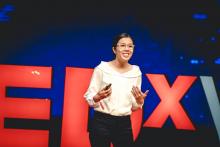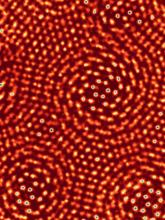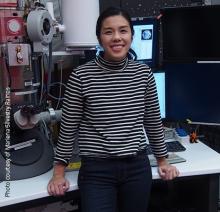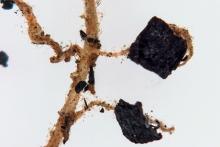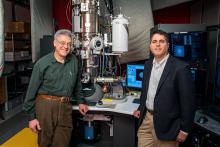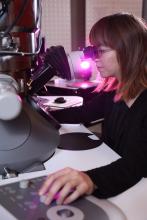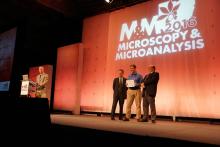News
Technological advances are transforming what researchers can study at the atomic scale.
Muller’s images represent the latest of a burst of technological advances that are triggering a revolution in what researchers can probe using transmission electron microscopes (TEMs) — devices as tall as a room that send beams of electrons through samples to explore structures down to a size scale smaller than an atom. The machines promise to give scientists the ability to see details previously out of reach, from the structure of fragile next-generation electronics materials, to the innards of porous substances that can separate gases.
A new detector technology lets us more than double the resolution of our electron microscope, resolving features 0.4 Angstoms apart. With a record resolution well below the shortest bond length, finding a good test object was a challenge. Twisted bilayers of two-dimensional molybdenum sulfide gave us the world's smallest ruler - where the projected distance between atoms could be made arbitrarily small.
read about it here.
The Cornell press release is here, with an update for the recognition by the Guiness Book of Records!
Congratulations to Kayla, “Use it!” Lemelson-MIT Prize Winner for her work on the Electron Microscope Pixel Array Detector (EMPAD) and airSTEM!
More information
Cornell University graduate student awarded Department of Energy fellowship
Ames, Iowa (September 18, 2017)
Gabriela Correa, a doctoral candidate in David Muller’s group at Cornell University, has been awarded a Department of Energy Computational Science Graduate Fellowship (DOE CSGF) to support her Materials Science research. Correa, from Sleepy Hollow, New York, received bachelor’s degrees in Mathematics and Electrical Engineering from the University of Massachusetts Amherst. Less than 5 percent of applicants are chosen for the fellowship each year. The DOE CSGF, administered by the Krell Institute of Ames, Iowa, is funded by the DOE’s Office of Science and the National Nuclear Security Administration. Each year, the program grants fellowships to support doctoral students whose education and research focus on using high-performance computers to solve complex science and engineering problems of national importance. Since it was launched in 1991, the DOE CSGF has supported 436 students at more than 65 universities. DOE CSGF students receive full tuition and fees plus an annual stipend and academic allowance, renewable for up to four years. In return, recipients must complete courses in a scientific or engineering discipline plus computer science and applied mathematics. They also must do a three-month research practicum at one of 21 DOE laboratories or sites across the country. Correa joins a group of 20 first-year fellows in 2017, bringing the total number of current DOE CSGF recipients to 79 students in 14 states. The fellowship and related practicum experiences are effective workforce recruitment tools for the national laboratories. Nearly a quarter of all DOE CSGF alumni currently work or have worked in a DOE lab setting. Others pursue careers in academia, industry or government, where they introduce and advocate for computational science as a tool for discovery.
For more information on the DOE CSGF, contact the Krell Institute at 515-956-3696 or visit http://www.krellinst.org/csgf.
The Muller group has helped to discover previously unknown electron transfer pathways in Biochar in soil, which may be vital for soil microorganisms. The cross-disciplinary study was led by Tianran Sun and Johannes Lehmann from Cornell's Department of Crop and Soil Sciences. Read more at the Cornell Chronicle! http://www.news.cornell.edu/stories/2017/03/researchers-discover-high-de...
Read about the Electron Microscope Pixel Array Detector (EMPAD) in the Cornell Chronicle!
"like taking a photograph of a sunset that showed both details on the surface of the sun and the details of darkest shadows”
http://www.news.cornell.edu/stories/2017/03/new-electron-microscope-sees...
Gabriela Calinao Correa was selected to receive a 2017 National Science Foundation (NSF) Graduate Research Fellowship Program (GRFP) Fellowship!
Watch Prof. Muller explain the behaviour of gold atoms on Nova's Treasures of the Earth: Metals on PBS!
Warning: The narrator may have decided to call me Mewler.
Microscopy and Microanalysis 2016, Columbus Ohio: Barnaby Levin receives a Student Scholar Award for his abstract: "Reverse Engineering Cadmium Yellow Paint from Edvard Munch's "The Scream" with Correlative 3-D Spectroscopic and 4-D Crystallographic STEM". The abstract describes how we're combining spectroscopy and 4D-STEM to reveal the nanoscale structure of paint from Edvard Munch's masterpiece, The Scream (c. 1910, Munch Museet, Oslo, Norway). Our work is being done in collaboration with scientists at the University of Delaware, and at the Munch Museum in Norway.
The abstract can be accessed online at: https://www.cambridge.org/core/journals/microscopy-and-microanalysis/art...

